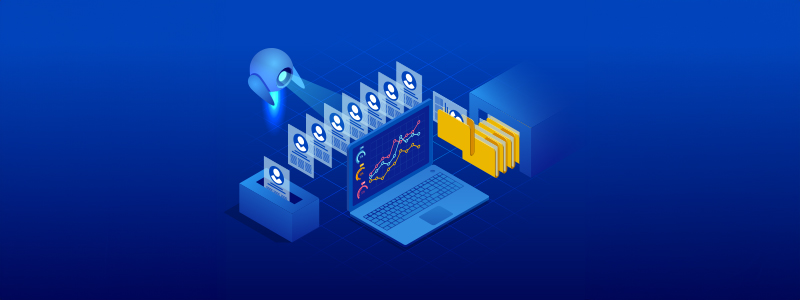
What Are AI Agents? Definition, Types, Applications for Enterprises, and More!
Teams are spending as much as 71% of their time on administrative tasks and manually entering data. But what if there was a way to automate all their repetitive work so they could focus on performing higher-order tasks, creating value, and driving actual ROI?
That’s what AI agents can do for you.
What Are AI Agents?
AI agents are software systems or programs that perform tasks for a user (or for another system). These agents can be configured to be capable of reasoning, planning, memorizing, and executing actions with a certain degree of autonomy.
At their core, AI agents follow a simple cycle:
- they observe their environment,
- gather data from different sources,
- process the information,
- and act to achieve a defined goal.
While the users set the objectives, the AI agent determines the best steps to reach them.
AI agents can achieve all this because of the multimodal capacity of the generative AI models (LLMs) they’re based on. This means that AI agents can process multimodal information such as text, video, audio, code, and more simultaneously.
Many experts believe Agentic AI, or AI agents, is the link between Generative AI (think ChatGPT, Gemini) and Physical AI (think self-driving cars, AI-powered robotics). In other words, AI agents take generative AI a step further by combining AI with automation.

Why AI Agents Are the Next Big Thing
Imagine this: Your inbox is organized, deadlines feel manageable, and routine tasks are handled effortlessly. Instead of getting buried in reports, customer requests, or financial reconciliations, you have an intelligent assistant that streamlines workflows, prioritizes tasks, and ensures nothing falls through the cracks.
With an AI agent working alongside you, information is at your fingertips, processes run smoothly, and you can focus on the work that drives real impact. AI agents can automate repetitive tasks, understand, reason, and adapt so you can work smarter.
Whether it’s a virtual assistant drafting reports, an AI-powered financial analyst reconciling accounts, or an intelligent customer service agent resolving inquiries, AI agents hold the potential to transform the way you interact with technology.
In fact, McKinsey reports that AI agents can automate as much as 70% of the work hours of the global workforce.
With a game-changing impact like that, enterprises that invest in building AI agents can not only gain a competitive advantage but also reap significant efficiency and cost benefits.
Build AI Agents in Hours Instead of Weeks
Astera takes the grunt work out of building AI. Our visual builder lets you design, develop, and deploy AI agents with simple drag-and-drop, a vast library of functions, and a variety of pre-built templates.
Connect With Us to Learn More.AI Agents vs. Traditional Gen AI Models (& Intelligent Agents)
AI agents and Generative AI models serve different purposes in enterprise applications. While both leverage artificial intelligence, they differ when it comes to their capabilities, adaptability, and decision-making. Here’s how:
Static Models vs. Adaptive Agents
Traditional AI models are typically static. They rely on pre-trained algorithms and require human intervention to improve over time. They analyze data and provide insights but do not adjust their behavior dynamically.
In comparison, AI agents are adaptive. They continuously learn from new inputs and interact with their environment to achieve specific goals.
Rule-Based Automation vs. Autonomous Decision-Making
Rule-based automation, often associated with traditional AI models, follows strict if-then logic. It performs well in structured environments where predefined rules cover all possible scenarios.
Autonomous AI agents, however, operate beyond fixed rules. They assess situations dynamically, learn from past experiences, and make autonomous decisions.
Example: Chatbot vs. Autonomous Virtual Assistant
Gen AI Model (Chatbot)
A rule-based customer support chatbot provides scripted responses based on predefined keywords. If a question falls outside its programmed responses, it escalates the query to a human agent.
AI Agent (Autonomous Virtual Assistant)
A virtual assistant powered by AI agents understands intent, retrieves information from various sources, learns from past interactions, and provides contextual responses. If it encounters a complex issue, it determines whether it should attempt resolution itself or escalate to a specialist.
Are AI Agents the Same as Intelligent Agents?
The terms intelligent agents and AI agents are often used interchangeably, but they have distinct meanings. While all AI agents are intelligent agents, not all intelligent agents rely on AI.
Intelligent Agents
An intelligent agent is any system that perceives its environment and takes actions to achieve specific objectives. These agents can be software-based (e.g., search engine crawlers, rule-based automation systems) or hardware-based (e.g., robotic vacuum cleaners).
Intelligent agents follow predefined rules and may or may not involve AI techniques like machine learning. They typically include:
- Sensors or data inputs to perceive the environment
- Decision-making mechanisms based on rules or logic
- Actuators or outputs to interact with the environment
AI Agents
AI agents are a subset of intelligent agents that leverage AI techniques such as machine learning (ML), deep learning, or natural language processing (NLP) to enhance their decision-making. These agents can learn from data, adapt over time, and handle complex, dynamic environments.
Unlike rule-based intelligent agents, AI agents can improve their performance without explicit programming for every possible scenario. They are used in areas where decision-making involves uncertainty, optimization, or pattern recognition.
How AI Agents Work
AI agents vary in complexity. Some follow straightforward rules, while others leverage machine learning to refine their decision-making over time.
Their ability to work continuously, adapt to new conditions, and streamline operations makes them valuable across industries, from mortgage document processing, and accounts payable (AP) automation to and beyond (more on their real-world applications later).
Let’s look at the steps an AI agent typically follows to achieve its goals:
Perception (Data Collection)
AI agents gather data from their environment through various input mechanisms or sensors. This data helps them understand the current state and context in which the agents operate.
For instance:
- Chatbots receive user inputs via text or voice, allowing them to understand user queries and intents.
- Robots use cameras, microphones, and other sensors to perceive their surroundings, enabling navigation and interaction with objects.
- AI agents access databases, APIs, and real-time data streams to monitor system statuses or market trends.
This data guides the agent’s subsequent reasoning and actions.
Processing and Reasoning
The agent then processes the collected data to inform decisions. This stage involves several steps, including:
- Analysis: Interpreting the gathered data to extract insights. For instance, a chatbot analyzes user input to identify the intent behind a query.
- Planning: Developing a sequence of actions to achieve the desired goal. This may involve setting sub-goals and determining the optimal course of action.
- Decision-Making: Selecting the best action based on the analysis and planning phases. This process utilizes machine learning (ML) models or predefined rules to evaluate potential outcomes.
Advanced AI agents may use sophisticated algorithms to perform complex reasoning, enabling them to handle multiple tasks and adapt to dynamic environments.
Action Execution
After determining the appropriate course of action, the agent executes the chosen tasks to influence its environment. Examples include:
- Chatbots responding to user inquiries with relevant information or assistance.
- Robots manipulating objects or moving to specific locations based on their objectives.
- AI agents automating processes such as data entry, system monitoring, or transaction processing.
The effectiveness of an AI agent largely depends on its ability to perform these actions accurately and efficiently.
Learning and Adaptation
AI agents can learn from past inputs and outcomes and adapt their behavior over time. This learning process involves:
- Feedback Integration: Incorporating outcomes from previous actions to refine future decision-making. For example, if a chatbot’s response does not satisfy a user, it can adjust its approach in subsequent interactions.
- Model Updating: Continuously improving underlying algorithms based on new data, enhancing the agent’s performance and accuracy.
- Environment Adaptation: Modifying strategies to align with changing environmental conditions or objectives.
Through learning and adaptation, AI agents become more proficient over time, leading to increased autonomy and reliability.
Technologies Powering AI Agents
AI agents rely on multiple technologies to operate effectively in enterprise environments. Let’s briefly discuss some of the most important ones:
Machine Learning and Deep Learning
These technologies allow AI agents to analyze data, recognize patterns, and make data-driven decisions.
Reinforcement Learning (RL)
Reinforcement learning enables AI agents to learn by trial and error, optimizing their actions to achieve specific goals.
Large Language Models (LLMs)
LLMs, such as GPT-based models, help AI agents understand and generate human-like responses.
Multi-Agent Systems (MAS)
MAS involves multiple AI agents working together to achieve a common goal, often in distributed environments.
Natural Language Processing (NLP)
NLP enables AI agents to understand, process, and respond to human language.
Knowledge Graphs & Symbolic AI
These technologies allow AI agents to store and retrieve structured knowledge, improving their reasoning capabilities.
If You Know Your Data, You Can Build Your AI
Astera empowers domain experts in practically every field to build AI agents in hours instead of weeks. Just drag-and-drop or start with our templates to design, develop, and deploy agents effortlessly.
Learn MoreTypes of AI Agents (with Examples)
Considering that agentic AI is a relatively new domain, more types of AI agents are expected as agentic AI finds more applications in different fields. As of now, there are seven common types of AI agents:
Simple Reflex Agents
These AI agents are the simplest ones, as they make decisions based on their current input by responding immediately to their environment without requiring any learning or memory processes.
Simple reflex agents follow predefined rules that dictate how they respond to different inputs. While they’re not the most sophisticated, their direct approach makes their implementation easy.
Example: A finance team can set up a simple reflex agent for invoice validation which can automatically reject any invoices that are missing key details such as Tax ID, invoice number, etc. The AI agent can work in combination with invoice data extraction software to validate and process invoices automatically.
Model-Based Reflex Agents
Model-based reflex AI agents are more advanced than simple reflex agents in that they rely on an internal model of the environment, which is updated as they receive new information, known as percepts.
These AI agents are typically used in environments where all information isn’t readily available. Their decision-making is based on their internal model, new percepts from the input sources, and an algorithm or a set of rules, to decide the best course of action.
Example: Enterprises can utilize AI agents to serve as IT virtual assistants that can detect if a user reports slow network speeds, check recent service outage logs, and recommend troubleshooting steps.
Goal-Based Agents
As the name suggests, goal-based AI agents are designed to achieve specific objectives. They do this by evaluating the outcomes of their actions. In other words, these agents design the sequences of actions required to achieve a desired goal through search and planning algorithms.
Goal-based agents are different from reflex agents in that instead of reacting to inputs, they perform strategic planning and execution to perform a task.
Example: A CRM-integrated AI agent can analyze a list of potential clients, consider previous interactions, rank prospects based on conversion probability, and then design and execute a personalized outreach strategy for each prospect.
Utility-Based Agents
Utility-based AI agents take decision-making a step further by aiming for a goal and optimizing the outcome based on a utility function. This function helps the agent evaluate different possible actions and choose the one that maximizes the expected benefit.
These agents are particularly useful when multiple ways exist to achieve a goal, but some outcomes are more desirable than others.
Example: AI agents in supply chain management can optimize procurement and distribution based on multiple variables, such as cost, delivery time, and demand fluctuations. A utility-based agent can assess vendor pricing, real-time demand forecasts, and transportation costs to determine the most cost-effective way to fulfill orders.
Learning Agents
Learning agents continuously improve their performance over time by learning from past experiences. These agents rely on techniques such as reinforcement learning, supervised learning, or unsupervised learning to refine their decision-making. An AI prompt (instruction, data input, or environment setup) helps guide their learning process.
Unlike other AI agents that operate based on predefined rules or models, learning agents adapt by identifying patterns, analyzing feedback, and improving their strategies.
Example: A learning AI agent can be used in fraud detection. The agent can learn from past fraud attempts and customer spending patterns. When detecting suspicious transactions (e.g., a large withdrawal from an unusual location), it adapts its risk assessment models over time to reduce false positives.
Hierarchical Agents
Hierarchical AI agents are structured in layers, where high-level decision-making guides lower-level tasks. These agents break down complex problems into smaller sub-tasks, allowing for modular and scalable decision-making.
By using a hierarchical approach, these agents can manage tasks more efficiently, ensuring that simpler actions are executed at the lower levels while more strategic planning happens at the higher levels.
Example: Hierarchical AI agents can be used in HR systems to scan resumes, rank applicants, schedule interviews, and automate onboarding documentation. One level of AI handles applicant screening, another manages interview coordination, and a third ensures compliance with onboarding policies.
Multi-Agent Systems
Multi-agent systems involve multiple AI agents working together, either collaboratively or competitively, to achieve a common goal. These agents communicate, coordinate, and sometimes negotiate to make collective decisions. Multi-agent systems are used in environments where multiple independent agents must interact to solve complex problems efficiently.
Example: A multi-agent system for enterprises can continuously assess risks across various departments (finance, compliance, cybersecurity) and provide real-time insights. A corporate risk management AI consisting of multiple agents can monitor different risk factors:
- One AI agent scans for financial irregularities.
- Another agent monitors regulatory compliance updates.
- A cybersecurity agent detects potential security threats.
These AI agents can collaborate and alert decision-makers about high-risk scenarios, ensuring proactive risk management.

Real-World Applications of AI Agents
AI agents can transform industries by automating complex workflows, improving decision-making, and enabling businesses to operate more efficiently. Let’s look at some popular real-world use cases where AI agents can help:
Customer Service: AI Chatbots & Virtual Assistants
AI-powered virtual assistants enhance customer support by handling inquiries, resolving issues, and escalating complex cases when necessary. Unlike basic chatbots, these agents continuously learn from interactions to improve their responses.
For example, a banking AI agent can help customers check balances, dispute transactions, and even provide personalized financial advice.
Healthcare: AI Agents for Diagnostics & Patient Monitoring
AI agents support healthcare providers by analyzing patient data, monitoring vitals, and assisting with diagnostics.
For instance, AI agents in healthcare can analyze patient symptoms, cross-reference medical databases, and suggest potential diagnoses, helping doctors make informed decisions faster.
Finance: Algorithmic Trading & Fraud Detection
Financial institutions use AI agents for real-time market analysis, trade execution, and fraud prevention.
A good example is how AI agents in trading can assess market trends, execute trades based on real-time analysis, and adjust its strategies dynamically to optimize profitability.
Manufacturing: Robotics & Process Automation
AI agents streamline manufacturing operations, optimizing production schedules and ensuring quality control.
For instance, AI agents in predictive maintenance can monitor machinery sensors, detect potential failures before they happen, and schedule preventive maintenance automatically.
Marketing & Sales: AI-Driven Personalization & Service
AI agents analyze customer preferences and behavior to deliver personalized recommendations.
For example, an AI agent in email marketing can select the best time, format, and messaging for customer outreach based on engagement data.
Cybersecurity: Threat Detection & Automated Response
AI agents detect cyber threats in real-time and respond autonomously to mitigate risks.
For instance, an AI agent in cybersecurity can monitor network traffic, identify suspicious activity, and automatically isolate compromised devices to prevent breaches.
How to Build and Train an AI Agent
There are multiple approaches to building an AI agent. You can develop your AI agents in-house through code-based or low-code platforms, outsource development to vendors, or purchase pre-built solutions.
Purchasing Pre-Built AI Agents
The first approach to building agents is to not build one at all and instead buy one. However, the problem with buying a ready-made AI agent is that it is trained on generic data. Building your own AI agent means you can train it on your enterprise data for better performance.
Outsourcing Your AI Agent Development
You can also choose to outsource your AI agent development to third-party vendors, but this approach also comes with its own set of challenges. For instance, you’d have to share confidential data and go through multiple rounds of back-and-forth to even have a shot at getting it done right.
Building Your Own AI Agents
Coding Approach
If you choose in-house development, you’ll have to invest in tens of resources (data scientists, ML engineers, and software developers) with expertise in ML frameworks such as TensorFlow and PyTorch, NLP libraries such as spaCy and NLTK, and deployment tools such as Kubernetes and Docker.
Using a Visual Drag & Drop Solution
The last, and the best, approach is to use a visual platform such as Astera’s AI Agent Builder. This approach allows you to build AI agents with limited AI expertise and technical knowledge by leveraging a drag-and-drop interface.
Learn more about key factors to keep in mind when building your AI agents.
Astera AI Agent Builder: Your AI, Powered by Your Data
Astera AI Agent Builder is the fastest way to build, test, and deploy AI agents that are trained on your data. With Astera, both technical and non-technical users can deploy and manage AI agents without having to write complex code.
Here’s why Astera is your best bet if you’re looking for a visual platform to build AI agents:
- Build AI Agents at Supersonic Speeds: With Astera, you can convert ideas into AI agents within hours. With low coding involved, all you need to know is your data, and you’re ready to go!
- AI Trained on Your Data: Connect to the LLM of your choice (OpenAI, Anthropic, Mistral, Llama), train it on your enterprise data, and have your AI agent ready for deployment (on-premises, in the cloud, or hybrid!)
- Enterprise-Ready From the Get-Go: Our platform is built for flexibility, security, and scale. Run agents in your environment and keep full control of your data throughout the process.
- AI Agent Creation for Everyone: Empower your teams and turn business and data experts into AI visionaries. Reduce reliance on technical teams to build AI agents at scale for practically every function!
- Iterate and Optimize with Agility: Build, test, and optimize multiple variants in a simple drag-and-drop environment. Refine AI prompts, evaluate performance, and continuously improve without having to start from scratch every time.
Ready to see the future of AI agents? Get in touch with us to learn more.
 Astera AI Agent Builder - First Look Coming Soon!
Astera AI Agent Builder - First Look Coming Soon!

